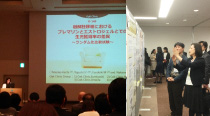
The Oak Group actively participates in academic societies held in Japan and overseas in order to obtain the latest information and techniques on infertility treatment and to present the research results at this hospital.

[Can the location of a trophectoderm biopsy contribute to human blastocyst development ?]
Does the degree of development of human blastocysts depend on the location of the blastocyst biopsy?
(Takano Tomoe, Funabiki Miyako, Taguchi Sagiri, Saji Fumie, Amano Namiko, Young Louise Kate and Nakamura Yoshitaka)

"Differences in live birth rate between premarin and estrogel in thawed embryo transfer-randomized controlled trials-"
(Masako K, Taguchi S, Funabiki M and Nakamura Y)
"A retrospective study of the Endometrial Receptivity Array (ERA)"
(Yuri Iwaki, Michiko Kobata, Chizuru Shito, Kaori Yamaguchi, Tomoe Takano, Fumie Saji, Louise Kate Young, Namiko Amano, Sasaki Taguchi, Miyako Funabiki, Yoshitaka Nakamura)

"Outcomes of infertility patients undergoing estrogen rebound"
(Yuri Iwaki)

A briefing session was held on new technologies that are expected to improve the quality of embryos of overseas companies.
As it became a new field, doctors asked a series of positive questions.

A briefing session was held on a subcutaneous injection pen that can be used at home.
The drug has already been introduced at our hospital, but as the number of patients requesting self-injection or remote treatment that eliminates the need for daily visits is increasing, a study session was held again.
Letters from Patients
Oak Clinic was the fifth hospital I tried for fertility treatment.
I was so tired.
However, when I met and talked to Dr. Funabiki, I was happy and cried when she said, "It's okay! Let's do our best!"
Approximately two months after that date, the pregnancy judgment result came out.
If I hadn't met Dr. Funabiki, this little life wouldn't have been possible.
My son, who is so healthy, is one year old. Thank you very much to Dr. Funabiki and all the staff of Oak Sumiyoshi Obstetrics and Gynecology.
(I became pregnant and gave birth at the age of 40!)
When fertilized, the X chromosome of the sperm does not work and the fertilized egg grows normally, but if there is an abnormality in the gene called "Xist", the X chromosome of the sperm will continue to work and abortion or death will occur.
Is known to be.
A group at the National Center for Growth Medicine injected a special substance into 235 fertilized eggs of mice with abnormal "Xist" and gave birth to eight baby mice (two of which were normal adults). growth).
Abnormalities in the human gene "Xist" are thought to be one of the causes of "recurrent miscarriage", which is estimated to have 30,000 patients in Japan, and "primary ovarian insufficiency", which is estimated to be 100,000.
Future research is expected to lead to the elucidation of the mechanism of infertility and the development of treatment methods.
Through mouse experiments, two types of genes, "Myc" and "Mycn," play important roles in sperm stem cells continuing to replicate and divide to produce sperm, according to the Kyoto University Graduate School of Medicine.
A research team led by Professor Takashi Shinohara (Reproductive Biology) of the Department published in the US scientific journal.
Myc is one of the genes "Yamanaka factor" used in the production of iPS cells.
It has been found that deficiency in blood stem cells prevents cell differentiation and delays self-renewal division in neural stem cells.
Studies have shown that mice lacking one did not significantly affect spermatogenesis, but mice lacking both had less ability to replicate and divide sperm stem cells than normal mice.
We also found that mice lacking two had abnormal cell energy metabolism, which caused a decrease in replication ability.
It is expected to be useful for investigating the cause of male infertility and developing treatment methods.

| Hobbies | Musical appreciation |
|---|---|
| Interests | Electone |
| Favorite words | There is only one life |
| Message |
Our medical assistant is marked by the shining apron. We strive to ensure that medical examinations and treatments proceed smoothly, and welcome patients with a smile. |